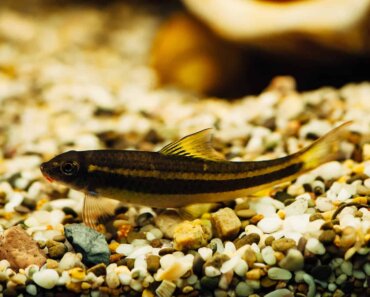
The Bucktooth tetra looks cute and innocent enough, but these are actually some of the most aggressive fish in the hobby! For that reason, although they can make an interesting addition to your home tank, they are also challenging to keep successfully, largely because of their nasty behavior.
Needless to say, this species is not recommended for beginner aquarists, although if you fancy adding some of these critters to your setup, keep reading to learn everything you need to know about their background and care.
The Bucktooth Tetra – At a Glance
| Bucktooth Tetra Info | |
|---|---|
| Scientific Name: | Exodon paradoxus |
| Common Name (species) | Bucktooth tetra |
| Family | Characidae |
| Origin | Amazon Basin and Guyana |
| Diet | Omnivore |
| Care Level | Advanced |
| Lifespan | Up to 10 years |
| Temperament | Aggressive |
| Minimum Tank Size | 55 gallons |
| Temperature Range | 72°F to 82°F |
| pH Range | 6.0 to 6.5 |
| Water hardness | 1 to 5 dKH |
| Filtration/Flow Rate | Moderate to fast flow |
| Water type | Freshwater |
| Breeding | Challenging but possible in the right conditions |
Origins and Natural Habitat
Bucktooth tetras are beautiful, shoaling fish that come from the Amazon Basin, Brazil, and Guyana, but that’s where their similarity to other tetra species ends.
These innocent-looking little fish are not peaceful but instead are predatory and extremely aggressive. Groups of Bucktooth tetras attack any other fish that get close enough, ripping off their victim’s scales one at a time!
Despite their nasty nature, Bucktooth tetras are still readily available in the aquarium trade and are considered a must-have species for many experienced hobbyists.
In the wild environment, the fish inhabit floodplain lagoons and rivers that flow through grassland habitats, gathering in large shoals at the water’s surface. The substrate is sandy and littered with driftwood and rocks, but vegetation is scarce.
Bucktooth Tetra Lifespan
A healthy Bucktooth tetra can live for around ten years or longer, provided you keep a well-maintained tank and offer your fish an appropriate diet.
Appearance
Bucktooth tetras look similar to most other varieties of tetra species, being torpedo-shaped. The fish are quite colorful, with a metallic silver base color body adorned with green, red, and yellow highlights. There are two large dark spots, one on the body and the other on the base of the tail.
The fish have transparent fins with just a tiny hint of yellow, and the dorsal, pectoral, and anal fins have red and orange splashes with a scattering of bright yellow flecks.
Despite their name, Bucktooth tetras don’t have buck teeth! In fact, you can’t even see the teeth unless you look very closely. However, their teeth are pointed and sharp, mostly to cope with the fish’s scale-eating habit, easily getting under the scales to rip them right off!
In addition, the teeth and lips are outward facing, again helping the Bucktooth tetra bite and damage other fish.
How Big Are Bucktooth Tetras?
Bucktooth tetras grow to an average size of around four or five inches in captivity, although they can get bigger in the wild.
Bucktooth Tetra Care Guide
As previously mentioned, the Bucktooth tetra is best kept for hobbyists with some experience as these are definitely fish with attitude and can be challenging to keep. However, if you fancy a challenge and are prepared to keep a one-species tank, this tetra could be something you want to consider.
With that in mind, here’s a guide to keeping the enigmatic Bucktooth tetra.
Tank Size
The first thing to know is that you need a spacious tank if you want to keep Bucktooth tetras. For a group of 12 fish, you’ll need an aquarium of no less than 55 gallons. Of course, a bigger tank is always better, especially if you want to keep a huge shoal of Bucktooth tetras.
But these are relatively small fish, so why do they need such a large tank?
For a start, Bucktooth tetras are very active and need lots of space to swim and explore. Also, these are shoaling fish, and they must live in a large group to avoid cannibalistic behavior or fighting.
Water Parameters
Bucktooth tetras are relatively undemanding regarding water chemistry and will do fine in water conditions that suit many species of South American tropical fish.
The water temperature in a Bucktooth tetra tank should be between 72°F and 82°F, with slightly acidic pH levels of 5.5 to 7.5 and a water hardness of 0 to 15 dKH.
Use a reliable aquarium testing kit to check the water parameters weekly and make any necessary changes to the water chemistry to keep your fish healthy and thriving. Perform weekly water changes, use an aquarium vacuum cleaner to remove uneaten food, organic waste, and plant debris, and clean the filter media every couple of weeks to keep the filtration system running efficiently.
Tank Decoration
In the Bucktooth tetra’s natural habitat, vegetation is relatively sparse, so you don’t need to worry too much about providing lots of live plants in their tank.
That said, a selection of live plants can provide the fish with somewhere to hide and explore, as well as help to keep the water healthy and clean. Java fern and Amazon sword make good choices, and a few floating plants can help to provide dappled shade. Keep the plants around the tank’s perimeter to create a natural look but leave plenty of swimming space for the fish.
The best substrate is a dark sandy material that keeps the natural vibe and reflects the substrate in the Bucktooth tetra’s natural habitat. Items like rocks, caves, and driftwood are also effective and provide plenty of nice areas for the fish to explore.
Lighting
Bucktooth tetras don’t need special lighting, and a standard aquarium light will do fine. Just be sure your lighting is sufficient for any live plants in your aquarium.
Water Flow Rate
In their natural environment, Bucktooth tetras live in relatively fast-flowing rivers with a good amount of current, so a reasonably powerful flow rate is best for their tank.
What Tank Mates Can Live With Bucktooth Tetras?
The simple answer to that question is none!
Because they are so aggressive, Bucktooth tetras are not suitable for life in a community tank and are much better kept in a single-species setup. Although these are quite small, a group of these fish can easily attack, take down, and even kill a larger fish, and any other tank residence will quickly become a food source.
Even powerful cichlids will be ripped up in a few minutes by a gang of hungry scale-eating Bucktooth tetras. Some hobbyists have tried keeping aggressive bottom-dwelling fish species with some success, although their safety is not guaranteed.
At the end of the day, even if a fish could keep clear of the Bucktooth tetra group, its health would undoubtedly suffer because of the stress of constantly swimming away and hiding from its tormentors.
Unfortunately, the same applies to shrimp, which will also be on the menu in a tank with Bucktooth tetras.
The bottom line: we recommend keeping your Bucktooth tetras in a single-species tank.
What Do Bucktooth Tetras Eat?
In the wild, Bucktooth tetras eat a diet that consists mostly of fish scales. A group will swarm over their prey and attack it from all sides, like a bunch of miniature piranhas.
Many Bucktooth tetra owners use dead or live feeder fish as a basic diet for their tetras, But they will also take high-quality protein sources like bloodworms, brine shrimp, earthworms, and similar.
You can also offer your fish commercial flake foods, but you must supplement that with high-quality protein-based food to keep the fish healthy and thriving.
Are Bucktooth Tetras Aggressive?
Yes, Bucktooth tetras are highly aggressive and cannot be kept safely with other fish.
In addition, you must keep Bucktooth tetras in large groups to truly thrive. That’s not because the fish suffer from stress or anxiety, but because if you don’t keep them in a shoal, they will quickly turn on each other!
There’s no scientifically determined number of fish you need to keep to avoid cannibalism developing, but ideally, you should have at least 12 in a group. Of course, if you have a really big tank, you could keep up to 50 of these beautiful fish.
It seems that when kept in very large groups, no single tetra will be targeted and killed. Instead, the fish will pick on unhealthy, injured, or weak specimens, especially in a small group.
Shrimp are also targeted, although we think snails should be fairly safe if you want to add some for variety and to help keep the tank free from detritus.
Health and Disease
Bucktooth tetras are relatively healthy and hardy fish, although they can still suffer from many common fish diseases that attack other freshwater species. The key to keeping your fish healthy is to maintain your tank correctly, keep up with weekly partial water changes, and feed your fish a correct, high-quality diet.
The most common disease that could attack your Bucktooth tetras is Ich or White Spot Disease. The first sign of this disease is when your fish starts flicking or rubbing against solid objects in the tank, including the substrate. As the disease progresses, a rash of tiny white spots appears on the fish’s fins and body, making diagnosis fairly straightforward.
Fortunately, you can treat Ich with an over-the-counter product you can buy in your local fish store.
Other signs of sickness to watch out for typically include the following:
- Ulcers or reddened patches on the skin
- Torn, bloody fins
- Increased or heavy breathing
- Resting on the bottom of the tank
- Inactivity
- Poor appetite
If your Bucktooth tetras show any of those symptoms, set up a quarantine tank, isolate affected individuals, and treat them with medication from your local pet store or vet center.
Breeding Bucktooth Tetras
Breeding Bucktooth tetras in captivity is incredibly rare and extremely challenging, although it is possible.
These fish are egg scatterers and have no parental Instinct whatsoever, so you’ll need to set up a separate spawning tank if you want to try to breed them. Set up the breeding tank with similar water parameters, and add some bushy fine-leafed plants or use a layer of fine mesh at the bottom of the tank.
The plants will give the eggs some protection. At the same time, the mesh allows the eggs to fall through, keeping them safely separated from the parent fish, who would otherwise eat them.
Bring the fish into breeding condition by feeding them a high-protein diet a few days before you want to start encouraging them to spawn. Choose a breeding pair and move them to the spawning tank.
Keep the water a couple of degrees warmer than usual to replicate the changing temperatures of the breeding season in nature. With luck, the female Bucktooth tetra will scatter her eggs around the tank. As soon as she does so, remove the adult fish before they have a chance to eat the eggs.
Caring for the Fry
The eggs usually hatch in two to three days, and the fry will eat the egg sacs to begin with. Once the baby fish are free-swimming, give them baby brine shrimp for food.
Unfortunately, like their parents, juvenile Bucktooth tetras are prone to cannibalism, so don’t be surprised if you lose a few of the babies. The best way to prevent that is to keep the fry well-fed so that they don’t resort to eating each other when they get hungry.
Availability and Price
Bucktooth tetras are surprisingly popular fish, and that makes them relatively easy to get hold of in the trade. You can expect to pay a few dollars for a single fish up to around $15 for a group.
Final Thoughts
Bucktooth tetras are not recommended for beginners, mainly because of their aggressive nature and ability to take down fish much larger than them.
However, if you create a natural-looking environment in a single-species tank with plenty of swimming space, a large shoal of these lively, colorful fish can look truly spectacular. Bucktooth tetras are pretty easy to care for and relatively hardy, provided you keep their tank clean and well-maintained and feed them a correct, high-quality diet.
Unfortunately, these fish are challenging to breed in captivity, although it can be done with luck and the correct spawning tank setup.
Do you have Bucktooth tetras? Do you keep a single-species tank, or have you found some tank mates that can cope with the tetras’ aggressive tendencies? Tell us in the comments box below!


























